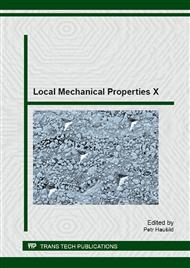[11]
This is very promising especially for applications like milling in aggressive environment. Conclusions From presented measurements following conclusions could be made: Both coatings (W, WN) are considered as a suitable for the FGM with a sharp phase boundary. Especially suitable substrates for these coating are: homogeneous substrates, substrates with low hardness or wear resistance. In other cases (hard substrates like WC+Co) there were only minor improvement but other advantages could be reached (like higher resistance to high temperature corrosion etc. ), but these properties were not studied in presented work. 1) Pure tungsten could be considered as coating with high toughness decreasing crack growth between layer interfaces. Since its ability of increasing hardness or wear resistance were negligible in all studied cases. 2) Tungsten nitride could be considered as high strength and abrasion resistant coating improving the surface properties, since tungsten nitride coat improved hardness and wear resistance, in the majority of cases. 3) The adhesion dependence on chemical bond (coating and the substrate) and the plastic properties of coatings was observed. Adhesion seamed to decrease in systems with high bonding energy of the substrate. Acknowledgement Research was supported by Czech Science Foundation grant P108/12/1872. Literature.
Google Scholar
[1]
A. Leyland, A. Matthews, On the significance of the H/E in wear control: a nanocomposite coating approach to optimised tribological behaviour, Wear, 246 (2000) 1–11.
DOI: 10.1016/s0043-1648(00)00488-9
Google Scholar
[2]
S. Grainger, J. Blunt, Engineering Coatings, second ed., Woodhead Publishing LLD, Abingdon, (1998).
Google Scholar
[3]
Huang et. al., A new model for fracture analysis of FGM under plane deformation, Mechanics of Materials, 37 (2005) 507 -516.
Google Scholar
[4]
F. Erdogan, M. Oztruk, Periodic cracking of Functionally graded coatings, International Journal of mechanical Science, 33(1995) 2179-2195.
DOI: 10.1016/0020-7225(95)00065-6
Google Scholar
[6]
Kadioglu et al., Crack problem for functionally graded layer on elastic foundation, International Journal of Fracture, 94(1998) 66-77.
Google Scholar
[7]
Information on http: /ateam. zcu. cz/FRVS_zprava_dalsi_studium_sosnova. pdf.
Google Scholar
[8]
EN 1071-3, Advanced technical ceramics, Determination of adhesion and mechanical failure.
Google Scholar
[9]
W.C. Oliver, G.M. Pharr, An improved technique for determining hardness and elastic modulus using load and displacement using indentation experiments, J. Mater. Research, 7 (1992) 1564-1583.
DOI: 10.1557/jmr.1992.1564
Google Scholar
[10]
, J. Nohava, .Š. Houdková, P. Haušild, On the use of different instrumented indentation procedures for HVOF sprayed coatings, Chemicke Listy. 2012, vol. 106, no. s3, pp.501-504. ISSN 0009-2770.
Google Scholar
[11]
J. Horník et. al., Evaluation of properties of CrN PVD coatings for FGM, In: METAL 2012, Ostrava: Tanger, 376 (2012), ISBN 978-80-87294-29-1.
Google Scholar


